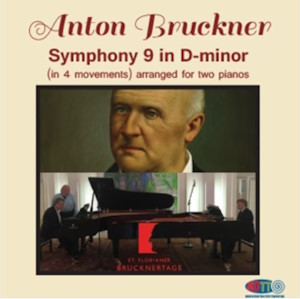
Anton Bruckner (1824-1896)
Symphony No 9 in D minor (WAB 109) (in four movements arr. for four hands on two pianos)
Till Alexander Körber & Reinhold Puri-Jobi (pianos)
rec. live, 20 August 2015, Sala Terrena, Stift St. Florian, Austria
High Definition Tape Transfer HDTT3610 [2 CDs: 80]
Recorded in a public concert at the Brucknertage, St Florian, in 2015 and engineered by John Gladney Proffitt, this was previously glowingly reviewed by both Jonathan Welsh here on MWI and Ken Ward in The Bruckner Journal. It is in four-movements, using Karl Grunsky’s transcription for the first three movements and William Carragan’s completion for the finale. Although the performance lasts just under eighty minutes, it is presented on two discs as 1:29 of applause is included at the end. Otherwise, although it is live, there is virtually no audience noise, a handful of faint coughs apart. Back in 2016 I also admiringly reviewed the Gramola recording of Rémy Ballot’s orchestral account of the Ninth coupled with this two piano arrangement, at the same venue as here as part of the Brucknertage festival, but performed by Klaus Laczika and Matthias Giesen and they played only the first three movements. I refer you to JW’s review for further background information and the contents of this HDTT issue.
The clarity of sound provided by John Proffitt is startling. Obviously there is no “cathedral acoustic” and the atmosphere is much more intimate; the performance has also been transferred at quite a high level so I found myself reducing the volume on first listening, but after that adjustment the balance between the pianos and the sonorities they produce are very satisfying. The cantabile quality so evident in the orchestral version translates well and the arrangement has been made so as to capitalise upon the capacity of a concert grand to sing like the human voice.
The tremolo opening is convincingly grand and monitory and I like the way in which the repeated, descending, bell-like phrases beginning at 3:14 are sharply articulated, contrasting with the ensuing lush, legato Gesangsperiode; the range of moods and colours created here is impressive. This is a long movement, so that variety is important in sustaining the listener’s attention. The climax fourteen and a half minutes in makes its mark but the gentler passages, too, are elegantly played, exhibiting excellent co-ordination between the two pianists. The coda is especially well executed, moving from mystery to heroic defiance.
The puckish, then demonic, Scherzo, too, is very effective in this arrangement, set in a piercing higher pianistic register to contrast with the bass rumblings, faithfully replicating the impact of the original, and the tripping semiquaver runs in the Trio rattle along engagingly.
The Adagio unfolds serenely and is treated to some especially delicate and sensitive pianism. I wondered whether Bruckner’s big chorale moments would be diminished by being rendered on two keyboards but they come across, so the outbursts in the first movement such as those at 9:20 and 11:46 with pounding chords are highly effective – and the “sunburst” at 14:55 is properly luminous.
The first five minutes of the finale are perhaps the most difficult for the pianos to negotiate as it is quite jagged, agitated music with frequent hiatuses and a succession of graduated climaxes, so the effect can be quite fragmented without the cushion of sound provided by a full orchestra but tension and cohesion are maintained throughout the twenty-two minutes of swiftly alternating moods and the movement culminates in a thunderous D major peroration.
I find myself pondering how this arrangement would sound to anyone not already acquainted with the original, orchestral version and of course I am no position to judge, but I would like to think that the essence of Bruckner’s miraculous music would be conveyed by it; I am certainly intrigued and entertained by the way it reveals new details even to someone supposedly familiar with the work.
Ralph Moore
Availability: High Definition Tape Transfers


















